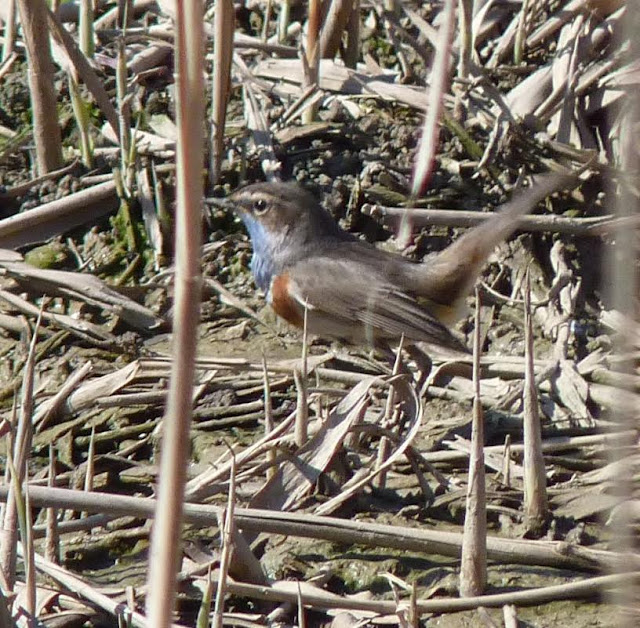Sunday morning and all good things must almost come to an end - but not yet. having said our goodbyes after breakfast we set off for the lighthouse with the feint hope that we might find the local Shag but it was not to be. Cormorants and Yellow-legged Gulls only so on round the corn to the Trumpeter Finch site where we came across Barbara and Derek Etherton doing the same thing, looking for that missing target bird from yesterday. Again, no joy but we did pick up a number of Black Wheatears, Stonechats and Black Redstarts along with a few House Sparrows. Also from here the first of the Lesser Black-backed Gulls seen during the morning.
 |
| Black Wheatears Oenanthe leucura (PHOTO: John Wainwright) |
Back to the public hide overlooking end of the lagunas (Hide 4) where the Flamingos and Avocets still dominated the seen along with a good raft of Cormorants. The end pool contained a mixture of Black-headed and Lesser Black-backed Gulls but also a dozen or so Sandwich Terns along with a handful of Slender-billed Gulls. A Sky Lark had greeted us to the immediate area and Chiffchaff was also recorded. On the water a range of waders including Kentish Plover, Little Stint, Dunlin, Sanderling, Black-tailed Godwit, Redshank and Black-winged Stilt. On the distant island a small flock of a dozen Spoonbill had come in over night.
 |
| A few of the many Flamingos Phoenicopterus roseus |
 |
| A very distant record shot of the Curlew Numenius arquata |
 |
| And then the flock of Dotterel Charadrius morinellus took to the air |
Shelduck, Cormorant, Spoonbill, Flamingo, Buzzard, Kestrel, Kentish Plover, Dotterel, Knot, Sanderling, Little Stint,Dunlin, Black-tailed Godwit, Curlew, redshank, Common Sandpiper, Black-headed Gull, Slender-billed Gull, Lesser Black-backed Gull, Yellow-legged Gull, Sandwich Tern, Collared Dove, Crested Lark, Barn Swallow, House Martin, Blue-headed Wagtail, White Wagtail, Black Redstart, Stonechat, Black Wheatear, Blackbird, Chiffchaff, Iberian Grey Shrike, Magpie, Spotless Starling, House Sparrow, Greenfinch.
Meanwhile, John and Jenny Wainwright had set off before us and they, too, were anxious to find the opposite entrance to the Dotterel site as well as explore any pond or river that they came across. Now back home in Salar, John has sent me his report of the journey home:
More sunshine reaching 28C today, no wind.
After packing the car and saying goodbyes, we
headed for 2.4km on the Retamar road, down to the beach and along to the left,
here, as we walked into the dunes a Subalpine Warbler sat atop a bush singing,
but he spotted us before we could get the cameras up. Also here we had Barn
Swallows, three Red-rumped Swallows, House and Sand Martins, Magpies, Thekla
Larks, Chiffchaffs, an Iberian Grey
Shrike, Black Redstarts, Greenfinches, two Hoopoes and as we made our way back
another Iberian Grey Shrike was logged.
From here we moved across to Los Norias and the
plastics works. Our first sightings were of Black-necked and Great Crested
Grebes, then Mallard, Little Grebe,
Cormorants, Grey Herons and Little Egrets. Above the House and Sand Martins,
Barn and Red-rumped Swallows hawked for food - and there was plenty for them if
there was as much above as down with us!
We then turned left into the greenhouse area where
we saw Red-crested Pochard, Pochard, Gadwall, Shovelers, more Great Crested,
Little and Black-necked Grebes. Lots of Chiffchaffs again as well as Sardinian
and Cetti´s Warblers plus three Spanish Sparrows and a male Blackcap. On the
muddy areas we saw Common and Green Sandpipers, Cattle Egrets, Blue-headed,
Grey and White Wagtails, Black-winged Stilts, Yellow-legged Gulls, Redshanks
and Sanderling. We drove down in between the greenhouses to one of out
favourite spots where we had a male Bluethroat, a Snipe, a Water Pipit and
another Common Sandpiper. As we pulled out from here a flock of Serins was noted
as well as Red-rumped and Barn Swallows. Just before turning right and exiting
the area a small flock of Meadow Pipits was seen.
 |
| Bluethroat Luscinia svecica (PHOTO: John Wainwright) |
Moving on to the Roquets de Mar we logged
Black-headed, Lesser Black-backed, Yellow-legged and Auduoins Gulls,
Red-crested Pochard, Black-winged Stilts, Common Coots, Shovelers, Greater
Flamingos, Little and Cattle Egrets, Teal, Sandwich Terns and a female Marsh
Harrier.
We then decided to head for Motril and book a hotel
for the night, but we ended up in Salobreña and the Charca de Suarez, where
Manolo was waiting for a Spanish group to turn up. He gave us a couple of
"authorised passes" and we headed into the reserve, the only extra
bird picked up here was a Purple Gallinule but a nice end to the day and the
visit.
Thanks John and, I believe, when we add on the extra birds seen on Friday and Saturday then the total for the week-end must surely have been close to 90 species.
Check out the accompanying website at http://www.birdingaxarquia.weebly.com for the latest sightings, photographs and additional information.
No comments:
Post a Comment